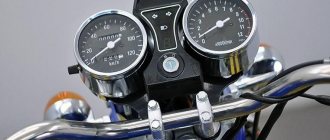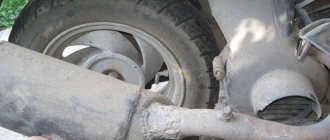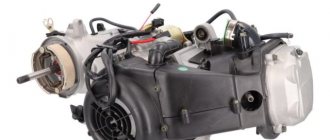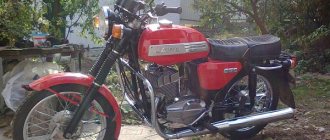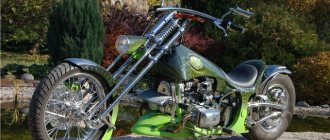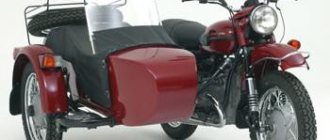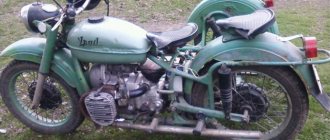Scooter tuning, how to properly tune a scooter Scooter tuning using the example of Honda Dio AF-18 Remove 50 - put 72. Replacing the piston on a scooter CVT tuning. Adjusting the weight of the variator weights using available materials
How do you do your own scooter tuning? Why does a scooter need tuning at all? To answer, we need to figure out why we need a scooter at all?
It’s one thing when a scooter makes it possible to forget about traffic jams and heat, and the fuel consumption is minimal. Everything is clear here with fifty dollars - the time comes when more dynamics and maximum speed are required/wanted. By intelligently approaching increasing the performance of a scooter, we will get the desired result. It’s another matter if we have a scooter as a means to stand out from the crowd, to amaze everyone with amazing acceleration and an impressive bass note from the exhaust. Here the direction of tuning is completely different. And in general, it often makes sense to simply change the scooter to a more powerful one rather than tuning a fifty-kopeck piece.
Speaking of low-budget boosting, click here, Cheap tuning of the Honda Dio scooter, and read the article about wallet-friendly tuning.
Well, later in this article we’ll talk about how and what to do for tuning, and for serious tuning of a scooter, with your own hands or someone else’s, and most importantly, wisely. And to such things as His Majesty, sir, “big scooter tuning”, i.e. Scooter tuning, which is noticeably superior to budget ones both in scale and in cost, must be approached extremely meticulously and carefully. This means that you can’t do it without the skill and instinct of a mechanic.
However, let’s start small here too.
So, after running in and removing the speed limiters (chokers), we have several ways to increase the maximum speed a little and get a much more powerful engine with almost the same resource. Don’t forget about the technical condition of the remaining parts and components of your scooter, otherwise the simplest and most inexpensive do-it-yourself tuning can result in a rather complicated and expensive scooter repair! already, perhaps, by someone else’s, more skillful hands . So:
Don’t forget about the technical condition of the remaining parts and components of your scooter, otherwise the simplest and most inexpensive do-it-yourself tuning can result in a rather complicated and expensive scooter repair! already, perhaps, by someone else’s, more skillful hands . So:
- Change the scooter muffler to a tuning resonance pipe that fits your CPG (pipes such as Laser X, LeoVince ZX, Technigas Next - R in various versions may be suitable) or to a “torque” exhaust (Polini No Smoke, LeoVince SP3/Turing, Techigas Silent Pro). Also rebuild the transmission part in accordance with the characteristics of the installed tuning pipe. This will allow you to raise the maximum speed of the scooter by another 10-15 km/h (for resonant exhaust) and will give an increase in dynamics.
- Get a carburetor with an optimal diffuser diameter. For 50-70cc, the most convenient to configure and install is a carburetor with a diffuser diameter of 17.5 mm, the most commonly used carburetor. There is an opinion that DellOrto tuning carburetors are of the highest quality, although by and large, the manufacturer does not really matter.
- CVT - replace with a sports one. In tuning CVTs, the process of adjusting to new parameters of a scooter’s engine is more accurate and of better quality - due to more advanced kinematics of moving weights. Tuning CVTs produced by Polini after 2005 are equipped with a rod lubrication system, which increases the efficiency of the entire scooter transmission. And due to the smoother and easier movement of the variator cheek along the guide sleeve, it improves the acceleration response of the scooter.
- The main way to increase the power of a scooter is, of course, to install a Sport class of increased volume. Generally speaking, this is the most radical and most effective method of increasing the performance of a scooter. Thus, you not only have an increased cylinder volume, but also a more competent and thoughtful system of the cylinder purging process (for a two-stroke engine) - that is, even more power. The main difference between two-stroke piston tuning kits from different manufacturers is precisely the different placement of windows. A cylinder head with an optimized combustion chamber shape - usually complete with a tuning CPG. Keep in mind that when installing piston engines with a larger piston diameter (volume), it is extremely important and necessary that the crankshaft and bearings be in perfect technical condition, otherwise large loads will simply destroy them very quickly.
In principle, the average person can stop at this level of scooter tuning, because the next stage is do-it-yourself scooter tuning, which allows you to develop up to 12-17 hp. on the shaft - this is the “design” of an engine on a tuning piston class Mid-Race and Race. And this is a qualitatively new level of tuning, and as mentioned above, for many it is easier to simply purchase a more powerful stock scooter than to tune it. So, tuning Mid-Race and Race class scooters.
Such engine tuning requires the installation of a reinforced crankshaft - with suitable bearings and a corresponding reinforced connecting rod. Only such tuning parts of a scooter engine are able to withstand increased shock loads and realize new power. Otherwise, you can forget about stable and trouble-free operation of the engine.
The crankshaft speed of an engine of this class begins to set the rhythm. 10,000 rpm requires adequate reliability of the components, which stock (i.e. standard factory) parts, such as main bearings, are not able to provide. In addition, the new thirsty engine needs appropriate power - the diameter of the carburetor diffuser should not be less than 17.5 mm for a racing piston engine. Also, the carburetor setting for this tuning engine must provide a good mixture at high speeds, otherwise overheating and further “sticking”, and in severe cases, the wedge of the cylinder cannot be avoided. It would be nice to install a 19 mm carburetor paired with a tuning sports air filter.
In fact, all the following steps for further tuning the scooter with your own hands will repeat the previous stage of boosting, only with the difference that it is necessary to use higher quality and more productive components of tuning kits. That is, instead of a regular sports CVT, it is strongly recommended to use Polini Evo or Malossi OverRange transmission tuning kits.
Tuning in this class allows you to develop dizzying dynamics and a hurricane maximum speed of over 100 km/h. In general, for normal use of a scooter in the city without too much investment in fuel and lubricants and consumables, this is the maximum possible tuning of the scooter. But such tuning allows you to enjoy real amazing dynamics and speed (this especially traumatizes the already unstable psyche of drivers of pseudo-sports cars, who for some reason underestimate the possibilities of tuning a scooter with their own hands and are perplexed when a “crazy stool” gives them heat from a traffic light as if they were standing , and often leaves them no chance for revenge  ).
).
So we have reached the pinnacle of boosting - tuning a Hi-End . These are uncompromising solutions that allow you to increase the liter power of a scooter engine to a figure exceeding 300 (three hundred!) horsepower per liter of volume! And this is without the use of all sorts of turbines and other sophisticated solutions like nitrous oxide or special fuel!
There are not so many companies involved in such developments. The main players in this field are Malossi, Polini, Kunda, 2Fast, Fabrizi, MetraKit. These are elite components and a triumph of high technology.
With this tuning, engine speed comes close to 20,000 rpm! There can be no savings here, the work is only for the result - the task of such a motor is to work out two 15-minute sessions and several hours of training, after which it is sent for inspection and subsequent replacement of worn-out components. Even crankshaft bearings most often come in special series and can only be purchased from the tuning studios themselves (Malossi and Polini have their own special bearings that were developed and manufactured exclusively for them).
Installation of the crankshaft, CPG and other components requires a very serious modification of the engine crankcase and chassis of the scooter; the use of rotary ignition is mandatory (which allows you to spin the engine to insane speeds without losing spark power), which implies the absence of all electrics not related to the scooter’s ignition system . The ratio in the gearbox is left to the taste and wishes of the owner.
The best examples of fine-tuning scooters using components of this class allow achieving time at a completely “adult” distance of 402 meters within 12-14 seconds, and not everyone, even seriously “charged” cars, are capable of such “feats”.
In urban use, the service life before replacing the ring is expressed as a figure from 1500 to 4000 km, so if it is possible to “feed” such an engine with first-class 98 gasoline (not the kind that is poured at 99% of gas stations, but real) and very expensive oil, then you can and sometimes ride such a monster to scooter-moto parties and amaze the imagination of those passing by with shining sides and polished engine covers, and after the cool motorcycle racers stop nervously giggling from the chirping of a newly started engine, accompanied by a fair amount of smoke from the exhaust pipe (you will have to pour oil “by eye” and, preferably, and, naturally, in not the most optimal proportions), open the trigger fully and take out a couple of “purebred” (ZZR 400 =) sports bikes. So let someone after this say that scooters are consumption for children “under 16”...
This, in general terms, is all about tuning scooters with your own hands. But each scooter is unique, each scooterist has his own requirements, so each scooter should be prepared based on many conditions - budget, requirements and the feasibility of one or another modification, because it is not for nothing that there are so many “transitional” classes on the scooter tuning market that do not fit into the standard ones the framework of one or another forcing class.
The following is a list of tuning kits provided by various scooter parts manufacturers.
We adjust valves (4t engines).
As mentioned earlier, the engine must be serviced before boosting.
Work that will help improve dynamics includes adjusting the valves. The procedure is suitable for tuning Chinese 4t scooters and other 4-stroke engines. For small-capacity equipment, it is recommended to carry out such adjustments at least once every 3, and preferably once every 2 thousand km. It is also necessary to carry out adjustments after manipulations with the CPG. Before you begin, you need to make sure that the engine has completely cooled down and that you have a set of keys (8,9) and feelers of 0.05 for the intake valve and 0.07 mm for the exhaust valve at hand. You can get to the adjusting nuts by first removing the valve cover. When access to the valves opens, the piston is installed at top dead center. Next, a feeler gauge is installed in the intake valve gap and, depending on the current position, an adjustment is made.
To increase or decrease the clearance, you need to loosen the lock nut (while holding the adjusting bolt), turn the adjustment bolt and, while holding it, tighten the lock nut back. Thus, we achieve a gap when the probe passes into it with little effort. After adjustment, make a full revolution of the crankshaft and make sure that the adjustment is accurate.
Electric scooter: buy or assemble it yourself?
We recommend that you read our previous material on a similar topic.
I would like to emphasize that it makes sense to assemble a serious mechanism on your own only if a person has really found a way to improve, improve factory designs, and do something extraordinary with specific practical goals. For example, as in the case of Thai engineer Joseph Memmel, who integrated a monocrystalline solar battery with a power of 180 Watts and a voltage of 24 Volts into his homemade electric scooter. This scooter is capable of traveling about 40 km at a speed of up to 30 km/h.
In other cases, when there is no innovative practical solution, it is better to buy a ready-made electric scooter: it is always a well-thought-out design with guaranteed reliable connections, mechanics and automation.
Scooter tuning – clutch tuning
| The centrifugal clutch, installed on the shaft of the variator driven pulley, gives the scooter the ability to move away independently as the engine speed increases. Often, when tuning, the scooter receives a fundamentally new character of the engine and, in order to fully realize its capabilities, the clutch must operate at higher speeds. Sometimes this can be achieved by replacing only the clutch springs, but sometimes (as a rule, starting with the Midrace tuning and higher) you have to change the entire clutch. Tuning clutches have pads made of more advanced material, and also often offer more options for tuning - it all depends on the class of the selected product. When tuning Midrace and above, the load on the clutch assembly is sometimes so high that in order to avoid overheating it is wise to replace the clutch complete with a bell, which is also offered by various tuning manufacturers. |
How to make an electric scooter with your own hands: important recommendations
An important point in the process of creating an electric scooter yourself is the choice of electric motor and battery. The capabilities of your brainchild, its speed and mileage depend on the correct configuration. As for the battery, you will have to choose between the efficiency of lead batteries and the more expensive lithium or lithium phosphate batteries. Due to the heavy weight of the former, they are impractical, while the latter type is much lighter and more durable. The choice will also depend on how you plan to use your new scooter: only in the warm season or ride it in winter.
Installing an electric motor is a crucial moment in the process of assembling an electric scooter with your own hands. Its silent operation can be achieved due to the absence of brushes and a commutator. More often it is mounted in the rear wheel, which rotates thanks to an electrical circuit that sends impulses to the driving front wheel.
You can search for components for an electric scooter yourself, and for many craftsmen this process is perhaps more enjoyable than assembling it. Some people spend weeks or months searching for the right battery or electric motor. Another solution, simpler but much more expensive, is to buy an electric scooter kit. For example, you can purchase a set with a motor wheel, a controller (preferably with a recovery function), a set of hydraulic brakes and a charger.
Scooter tuning – intake pipe tuning
The gasoline-air mixture prepared by the carburetor then flows into the crankcase through the inlet pipe. This part is sometimes mistakenly called a manifold, which is incorrect, since this pipe does not collect anything, but only directs the mixture into the crankcase
It is important that the flow area of this part is no less than the size of the carburetor, otherwise there is no point in installing a carburetor!
The flow area of the standard pipes on most scooters is such that you can easily use a 17.5 mm carburetor instead of the standard one. The same cannot be said about 19 mm carburetors! What can we say about such scooters, subjected to grief tuning with the help of 21 or even more carburetors without replacing the intake pipe!? Through tears we call these “scooters named after the 19th carb”..
An anecdote comes to mind: Stirlitz gave the dog gasoline and let him go. The dog ran 5 meters and fell. “The gasoline has run out,” thought Stirlitz.
Cleaning the muffler
The cleanliness of the muffler affects the power of the moped
Before you start changing anything in the exhaust system, I would like to give one piece of advice. The power of the scooter is directly affected by the cleanliness of the muffler. If it were possible to see the exhaust in a cross-section of the muffler, the owner of the scooter would be very surprised. After a certain mileage, the scooter's dynamics decrease, and owners begin to look for the reasons for this, finding them in a complete rework of the standard muffler or its replacement.
The reason for the loss of power, meanwhile, may be hidden in the condition of the engine itself. This will help determine the specialist you should contact before tuning. But the most common cause of loss of dynamics is soot that clogs the muffler. In this case, it is recommended to carry out cleaning in three ways.
First method: mechanical
It involves cleaning the muffler section (it is done with a grinder). The inside of the muffler is cleaned of soot using a wire or cable. The section in the section is closed by welding.
Second method: chemical
It involves pouring water with some kind of cleaner into the muffler. For example, caustic soda is suitable for this purpose. This cleaning has the advantage that the appearance of the muffler will not be affected in any way.
Cylinder-piston group.
Finally, the most effective improvement for any engine is replacing the CPG. But not just a replacement, but the installation of a new, larger piston. Fortunately, there are now many ready-made kits on the market; you don’t have to sharpen or adjust anything, as with Soviet equipment. Moreover, there is even a lot to choose from. For example, for various models with a volume of 50 cubic meters, they offer kits to increase to 63, 72, 82 and even 90+ cubic cm. In some cases, this is an almost double increase in power.
The situation is similar with larger engines, for example, for 125 cubic meters, sets of 150 or 170 cubic meters are sold. Some, in the process of tuning a scooter, manage to increase 150 cubic meters with their own hands to 225 cubic meters. Choosing the right part is not the most difficult thing, the most difficult thing is installing it. After all, this process involves almost complete disassembly of the engine. You will be faced with the need to have several special removable keys in your arsenal; you can ask them from friends or borrow them for the evening at auto repair shops. We strongly recommend studying the technical component in order to properly disassemble, replace the necessary elements and assemble the motor.
Alas, for some, increased power does not promise anything other than breakdowns or inadequate performance. This is because by significantly increasing power, you inevitably entail work on all other nodes. Let's imagine that we installed a new 92 cc CPG on an old 50 cc engine. The first thing to check is the condition of the connecting rod, crankshaft and bearings. Otherwise, they will fly first, followed by our new system of both cylinder and piston.
Great, we added new bearings to the CPG, an elbow with a connecting rod, now we can be sure of reliability. But the engine does not go faster, and we decide to purchase a new carburetor. Now the mixture is too rich, and we understand that the exhaust needs to be changed. After such modifications, the engine sounds loud, accelerates perfectly, but the maximum speed is slightly higher than before and the variator sounds strange. After installing a high-speed CVT, for example from the Italian manufacturer Polini, the engine will be able to fully realize its new power. The last stage is an inspection of the brake system; you don’t want to find out at a speed of 60 km/h that the brakes are now comparable to bicycle ones.
As a result, after replacing almost all the components, we got a very fast “flea” that can surprise your friends and experts in this technology. Over time, you can make changes to the chassis system, replace shock absorbers, and install more attractive wheels. Often, the modernization process does not stop there, and after tuning a scooter 50, 150 with your own hands, impressive improvements in appearance are made. The moped is repainted, panels are changed, new devices, lighting, and so on appear.
1 Classification of motors and upgrade options
Today, scooters are available with several types of motors. The most popular version of a small cc engine is the Chinese model 139qmb with a displacement of 49.6 cc. Next comes the 153QM model with a volume of 150 cm3 and the 157QMJ with a volume of 150 cm3. Thus, within each type of Chinese motor, the main engine parts are in principle interchangeable. This means that finding parts becomes an easy task.
Previously, the most popular scooter tuning kits were “whales” from Italian manufacturers Pallinni, Mallossi or Metrakit. These tuning kits, as a rule, include a huge range of parts, accessories and equipment for tuning scooters from well-known European, Japanese and Chinese manufacturers. However, in the case of Chinese-made mopeds, tuning with the help of European “whales” is too expensive for ordinary motorcyclists, and there are more and more Chinese scooters on our roads every year.
Today, tuning a scooter mainly comes down to increasing the engine capacity. The most tuned engines are 139qmb engines with a volume of up to 50cc. For example, instead of a standard piston and cylinder of 39 millimeters, wider analogues with a piston diameter of 44 to 50 millimeters are installed. In contrast to European and Japanese-made models, tuning of the “Chinese” mainly comes down to an increase in cubic capacity, as a result of an increase in engine power and the need for appropriate adjustment of the variator and other parts. And if with a 44 mm piston you can leave the factory cylinder head, then when replacing the 39 with a 52 mm version, you will have to change the cylinder head and recalibrate the carburetor. Thus, the easiest way to increase the cubic capacity for a 139qmb engine is to install a 44 mm piston, and you will also need to purchase additional gaskets. As for the larger Chinese-made engines (157QMJ and 153QM for 150 cm3), they are built on an identical platform and externally differ from the 139qmb model only in their longer length.
Scooter tuning – air filter tuning
| To properly power the engine, you need not only gasoline, but also air. Excess gasoline will do nothing for your engine unless it is enriched with enough air. To improve the air supply to the cylinder, special air filters are used. The most universal and balanced solution is to use a more efficient filter element, for example, Malossi Red Sponge, instead of a standard filter element. It is installed in the standard air filter box. Another type of tuning air filters is the so-called zero-resistance filters (or simply - FNS). When installing them, the standard box is completely removed, and in its place is a small filter element, usually either cylindrical or cone-shaped. It has less resistance, which improves cylinder power at high speeds. However, firstly, these filters are almost not protected from external influences of dust, dirt and water, and secondly, unlike standard air boxes, they do not have a resonance effect. As a result, installing such a filter requires a thorough and precise reconfiguration of the carburetor, which only a few specialists can handle. If the service center tells you that they can “promptly” and “easily” set up a carburetor to work with the Federal Tax Service, most likely the qualifications of the workers there are below average. Leave and never come back! |
